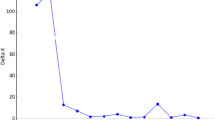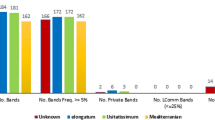Abstract
DNA-based molecular-marker techniques have been proven powerful in genetic diversity estimations. Among them, RFLP was the first and is still the most commonly used in the estimation of genetic diversity of eukaryotic species. The recently developed PCR-based multiple-loci marker techniques, which include RAPD, AFLP, Microsatellite-AFLP and inter-SSR PCR, are playing increasingly important roles in this type of research. Despite the wide application of these techniques, no direct comparison of these methods in the estimation of genetic diversity has been carried out. Here we report a direct comparison of DNA-based RFLP with various PCR-based techniques regarding their informativeness and applicability for genetic diversity analysis. Among ten pea genotypes studied, all the PCR-based methods were much more informative than cDNA-RFLP. Genetic diversity trees were derived from each marker technique, and compared using Mantel's test. By this criterion, all trees derived from the various molecular marker techniques, except for the tree derived from inter-SSR PCR, were significantly correlated, suggesting that these PCR-based techniques could replace RFLP in the estimation of genetic diversity. On the basis of this result, AFLP analysis was applied to assess the genetic diversity of a sample of accessions representing the various species and subspecies within the genus Pisum.
Similar content being viewed by others
References
Amos B, Pemberton J (1992) DNA fingerprinting in a non-human population. Curr Opin Genet Dev 2:857–860
Arens P, Odinot P, Heusden AW van, Lindhout P, Vosman B (1995) GATA- and GACA-repeats are not evenly distributed throughout the tomato genome. Genome 38:84–90
Arnau J, Housego AP, Oliver RP (1994) The use of RAPD markers in the genetic analysis of the plant pathogenic fungus Cladosporium fulvum. Curr Genet 25:438–444
Beckman JS, Soller M (1986) Restriction fragment length polymorphisms and genetic improvement of agricultural species. Euphytica 35:111–124
Ben-Ze'ev N, Zohary D (1973) Species relationships in the genus Pisum L. Israel J Bot 22:73–91
Beyermann B, Nurnberg P, Weihe A, Meixner M, Epplen JT, Borner T (1992) Fingerprinting plant genomes with oligonucleotide probes specific for simple repetitive DNA sequences. Theor Appl Genet 83:691–694
Blixt S (1972) Mutation genetics in Pisum. Agric Hort Genet 30:1–293
Botstein D, White RL, Skolnick MH, Davies RW (1980) Construction of a genetic map in man using restriction fragment length polymorphism. Am J Hum Genet 32:314–331
Brown PTH (1992) DNA fingerprinting in plant breeding. Agro-Food-Industry Hi-Tech November/December
Condit R, Hubbell SP (1991) Abundance and DNA sequence of twobase repeat regions in a tropical tree genome. Genome 34:66–71
Dallas JF (1988) Detection of DNA “fingerprints” of cultivated rice by hybridization with a human minisatellite DNA probe. Proc Natl Acad Sci USA 85:6831–6835
Delsney M, Grellet F, Tremousaygue D, Raynal M, Panabieres F (1988) Structure, evolution et expression de l'ADN nucleaire. Bull Soc Bot Fr 135:23–38
Dos Santos JB, Nienhuis J, Skroch P, Tivang J, and Slocum MK (1994) Comparison of RAPD and RFLP genetic markers in determining genetic similarity among Brassica oleracea L. genotypes. Theor Appl Genet 87:909–915
Ellis THN (1994) Approaches to the genetic mapping of pea. Mod Meth Plant Anal 16:117–160
Ellis THN, Turner L, Hellens RP, Lee D, Harker CL, Enard C, Domoney C, Davies DR (1992) Linkage maps in pea. Genetics 130:649–663
Epplen JT (1988) On simple GAT/CA sequences in animal genomes: a critical reappraisal. J Hered 79:409–417
Gebhardt C, Ritter E, Debener T, Schachtschabel U, Walkemeier B (1989) RFLP analysis and linkage mapping in Solanum tuberosum. Theor Appl Genet 78:65–75
Hamann A, Zink D, Nagl W (1995) Microsatellite fingerprinting in the genus Phaseolus. Genome 38:507–515
Havey MJ, Muehlbauer FJ (1989) Variability for restriction fragment lengths and phylogenies in lentil. Theor Appl Genet 77:839–843
Jeffreys AJ, Wilson V, Thein SL (1985) Individual-specific “fingerprints” of human DNA. Nature 316:76–79
Jung C, Pillen K, Frese L, Fahr S, Melchinger AE (1993) Phylogenetic relationships between cultivated and wild species of the genus Beta revealed by DNA “fingerprinting”. Theor Appl Genet 86:449–457
Kesseli R, Ochoa O, Michelmore R (1991) Variation at RFLP loci in Lactuca spp. and origin of cultivated lettuce (L. sativa). Genome 34:430–436
Kesseli RV, Paran I, Michelmore RW (1994) Analysis of a detailed genetic linkage map of Lactuca sativa (Lettuce) constructed from RFLP and RAPD markers. Genetics 136:1435–1446
Lapitan NLV (1992) Organization and evolution of higher plant nuclei genomes. Genome 35:171–181
Leberg PL (1992) Effects of population bottlenecks on genetic diversity as measured by allozyme electrophoresis. Evolution 46:477–494
Manly BFJ (1985) The statistics of natural selection. Chapman and Hall, London
Mantel N (1967) The detection of disease clustering and a generalized regression approach. Cancer Res 27:209–220
Marx GA (1987) A suite of mutants that modify pattern formation in pea leaves. Plant Mol Biol Rep 5:311–335
Messmer MM, Melchinger AE, Woodman WL, Lee EA, Lamkey KR (1991) Genetic diversity among progenitors and elite lines from the Iowa Stiff Stalk Synthetic (BSSS) maize population: comparison of allozyme and RFLP data. Theor Appl Genet 83:97–107
Miller JC, Tanksley SD (1990) RFLP analysis of phylogenetic relationships and genetic variation in the genus Lycopersicon. Theor Appl Genet 80:437–448
Monckton DG, Jeffreys AJ (1993) DNA profiling. Curr Opin Biotechnol 4:660–664
Moser H, Lee M (1994) RFLP variation and genealogical distance, multivariate distance, heterosis, and genetic variation in oats. Theor Appl Genet 87:947–956
Murray MG, Thompson WF (1982) Repeat sequence interspersion in coding DNA of peas does not reflect that in total pea DNA. Plant Mol Biol 1:143–153
Nei M (1987) Molecular evolutionary genetics. Columbia University Press, New York
N'goran JAK, Laurent V, Risterucci AM, Lanaud C (1994) Comparative genetic diversity studies of Theobroma cacao L. using RFLP and RAPD markers. Heredity 73:589–597
Nybom H (1990) Genetic variation in ornamental apple trees and their seedlings (Malus Rosaceae) revealed by DNA “fingerprinting” with M13 repeat probe. Hereditas 133:17–28
Perry BC, Mahinur SA, Arvind AB, Lavi U, Jiang R (1994) Length polymorphisms of simple sequence repeat (SSR) DNA as molecular markers in plants. In: Gresshoff PM (ed) Plant genome analysis. CRC Press, Boca Raton, London, pp 47–56
Poulsen GB, Kahl G, Weising K (1994) Differential abundance of simple repetitive sequences in species of Brassica and related Brassicaceae. Plant Syst Evol 190:21–30
Rogstad SH, Patton JC, Schaal BA (1988) M13 repeat probe detects DNA minisatellite-like sequences in gymnosperms and angiosperms. Proc Natl Acad Sci USA 85:9176–9178
Rus-Kortekaas W, Smulders MJM, Arens P, Vosman B (1994) Direct comparison of levels of genetic variation in tomato detected by a GACA-containing microsatellite probe and by random amplified polymorphic DNA. Genome 37:375–381
Saitou N, Nei M (1987) The neighbour-joining method: a new method for reconstructing phylogenetic trees. Mol Biol Evol 4:406–425
Schmidt T, Boblenz K, Metzlaff M, Kaemmer D, Weising K, Kahl G (1993) DNA fingerprinting in sugar beet (Beta vulgaris)-identification of double haploid breeding lines. Theor Appl Genet 85:653–657
Sharma (1996). Theor Appl Genet (in press)
Smith OS, Smith JSC, Bowen SL, Tenborg RA (1992) Numbers of RFLP probes necessary to show associations between lines. Maize Genet Coop Newslett 66:66
Tanksley SD, Young ND, Paterson AH, Bonierbale MW (1989) RFLP mapping in plant breeding — new tools for an old science. Bio Technol 7:257–264
Tinker NA, Fortin MG, Mather DE (1993) Random amplified polymorphic DNA and pedigree relationships in spring barley. Theor Appl Genet 85:976–984
Tivang JG, Nienhuis J, Smith OS (1994) Estimation of sampling variance of molecular-marker data using the bootstrap procedure. Theor Appl Genet 89:259–264
Tzuri G, Hillel J, Lavi U, Harberfeld A, Vainstein A (1991) DNA fingerprint analysis of ornamental plants. Plant Sci 76:91–97
Vedel F, Delseny M (1987) Repetitive and variability of higher-plant genomes. Pl Physiol Biochem 25:191–210
Vogel JM (1995) A microsatellite-based multiplexed genome assay (abtracts). In: Plant Genome. Scharago International, New York, p 84
Vos P, Hogers R, Bleeker M,Reijans M, Lee T van de, Hornes M, Frijters A, Pot J, Peleman J, Kuiper M, Zabeav M (1995) AFLP: a new technique for DNA fingerprinting. Nucleic Acids Res 23:4407–4414
Welsh J, McClelland M (1990) Fingerprinting genomes using PCR with arbitrary primers. Nucleic Acids Res 18:7213–7218
Williams JGK, Kubelik AR, Livak K, Rafalski JA, Tingey SV (1990) DNA polymorphisms amplified by arbitrary primers are useful as genetic markers. Nucleic Acids Res 18:6531–6535
Zabeau M, Vos P (1993) Selective restriction fragment amplification: a general method for DNA fingerprinting. European Patent Application 924026 29.7 (publication number: 0534 858 A1)
Zhou Z, Gustafson JP (1995) Genetic variation detected by DNA fingerprinting with a rice minisatellite probe in Oryza sativa. Theor Appl Genet 91:481–488
Zietkiewicz E, Rafalski A, Labuda D (1994) Genome fingerprinting by simple sequence repeat (SSR) — anchored polymorphism chain reaction amplification. Genomics 20:176–183
Author information
Authors and Affiliations
Additional information
Communicated by G. E. Hart
Rights and permissions
About this article
Cite this article
Lu, J., Knox, M.R., Ambrose, M.J. et al. Comparative analysis of genetic diversity in pea assessed by RFLP- and PCR-based methods. Theoret. Appl. Genetics 93, 1103–1111 (1996). https://doi.org/10.1007/BF00230132
Received:
Accepted:
Issue Date:
DOI: https://doi.org/10.1007/BF00230132




